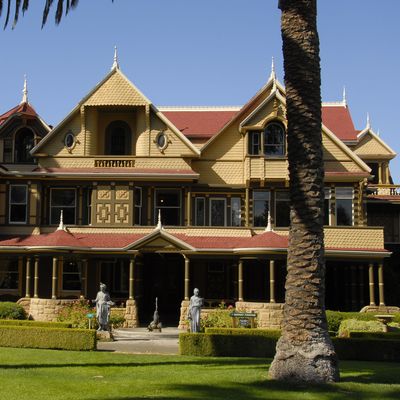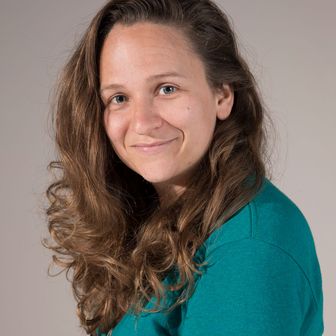
Winchester, opening this weekend, stars Helen Mirren as a mysterious widow living in a giant, ever-expanding mansion, commissioning nearly four decades of construction on her house in hopes of filling each new room with a restless ghost. The film kicks off with the arrival of a crooked, drug-addicted psychiatrist (Jason Clarke) at said mansion, who was sent on behalf of the Winchester Repeating Arms Company — which the widow has held a 50 percent controlling interest in since her husband’s death — to declare her unfit, so the board can take her shares and elbow her out. The doctor expects an open-and-shut case with an easy payday, but instead, finds a lucid woman deliberately spending her fortune on one of the most opulent homes ever constructed in America by the turn of the 20th century (complete with hundreds of rooms inhabited by spirits).
Winchester is a horror movie in the classic tradition, a spooky, almost quaint ghost story distinguished by its extravagant set pieces. But the most fascinating part about the film is that Mirren’s gigantic house is actually a real place that’s still standing today — and the history presented in the movie is pretty accurate, too. (Well, except for the plot about the vengeful Civil War ghost.) Though it’s known today as the Winchester Mystery House, it was called Llanada Villa when Sarah Winchester lived in it, and it’s located in San Jose, California. Winchester purchased it as an eight-room, two-story farmhouse in 1886, but once construction began, it carried on continuously for 24 hours a day, 365 days each year, for the next 38 years. (The only break came in the wake of the massive 1906 earthquake, and while the house was affected, the damage was not catastrophic.) Before you head to the theater to see Helen Mirren in head-to-toe black lace, consider the history of the actual house that Winchester built.
Who was Sarah Winchester?
Sarah Winchester was the widow of William Wirt Winchester, son of Oliver Winchester, a founder of the massively profitable Winchester Repeating Arms Company. William died of tuberculosis in 1881, and Sarah moved from Connecticut to California in 1885 with her inherited fortunate. The couple had a daughter, but she died just weeks after her birth, and Sarah never remarried or had more children, leaving the entirety of her wealth to be dedicated to her home and charitable works. Sarah died in her bedroom in 1922, and her obituary in the San Jose Mercury Herald described her as “a woman of the most retiring nature, extremely sensitive and opposed to publicity of any character,” who quietly donated large sums to charity over the course of her life. The obituary continued: “By her death, however, many of the unfortunate people in all parts of the country will have lost a faithful friend and benefactor.”
How has the house changed over time?
At the peak of construction, the house had 500 rooms. The current structure is down to a manageable 160 rooms comprising 24,000 square feet, and is filled with labyrinthine hallways, 40 bedrooms, six kitchens, 2,000 doors, 10,000 windowpanes, and oddly, 47 fireplaces with only 17 chimneys. There are also windows in the floor, and doors that lead straight into walls — including one from the séance room that opens up to nothing but an eight-foot drop, which leads directly down to a kitchen sink. But hey, we’re not here to tell the spirits how doors work.
The method behind construction was determined by the nightly séances Sarah would hold. She would communicate with spirits and sketch out the room that needed to be built to house them, so they could find peace. She’d hand over plans to her on-site foreman; the room would be built, and once its purpose had been fulfilled and the spirit was settled, it would be torn down. In a 1922 report from the Oregon Daily Journal, the magician Harry Houdini — who was set on debunking the house as an illusionist’s trick — visited the mansion and said, “Mrs. Winchester has a vast wardrobe of variously colored robes, and she uses a different robe for each spirit.” (We’d like to think that Sarah would have approved of Vulture’s love of outerwear.)
This sounds expensive.
It was! In an issue of Popular Mechanics from February 1924, an article about the “Spook Palace” estimates construction cost at the time to be around $5,000,000. That is equivalent to about $70,000,000 in present-day terms, but Sarah was reportedly very frugal in matters not related to construction (she also had income from a modest produce business she started). As a rep for the house tells Vulture, “Back in her day, she was Bill Gates–level rich” — and $70,000,000 over four decades sounds like someone’s allowance in the Gates household. Sarah also apparently paid her staff triple the going rate for services rendered, and provided housing on her land for unmarried workers (or found nearby housing for the ones who were wed) — so it sounds like working for the eccentric widow was actually a pretty sweet gig.
But what about the ghosts?
While the main ghost plot in the movie Winchester is invented, many would tell you that spirits are roaming the halls of the house even today. Jacob Williams, who runs marketing for the Mystery House, tells Vulture he was once standing on the front porch with his back turned toward the gardens when he felt a firm tap on his shoulder. He turned around and found no one was there, but insists he felt “a full-on finger pressing — it was like a pressure point on my shoulder, pressing on my shoulder. It was crazy!” He’s also heard his name whispered down hallways, and says tour guides who spend the most time in the house frequently hear theirs whispered as well. Many have also felt their hair being brushed while they were walking alone. One guide even tripped down a stair and felt a pressure on her arm as a voice audibly asked, “Are you okay?” No one else was around, but the guide says she felt a continued presence as she collected herself and walked away.
Hot spots in the house center around Sarah’s bedroom and séance room, as well as the third floor, where the servants’ quarters were located. Then there’s the basement, where “Clyde the wheelbarrow ghost” lives. “He’s a gentle guy,” says Williams. “He walks up and down what’s known as Steam Alley and carries a wheelbarrow full of coal, goes to the boiler, and goes back down the alley. And if he does make eye contact with you he just kind of nods and goes about his business. Or he leans up against a wall and he just hangs out.” (No one knows who Clyde really is; that’s just what they call him, because it’d be pretty rude not to give the regulars a name.)
The darkest reports include a general sense of unease, or detail people experiencing chills or hot flashes or dizzy spells, but Williams assures us — or maybe disappoints us — by saying, “No one has ever walked out with like a bruise or a bite mark.”
Is the actual house in the movie?
Williams says the film’s production team was scrupulous in re-creating details of the interiors and that what’s seen in the film presents a very accurate picture of the house as it stands today (and how it looked from historical records in the early 1900s). So while the bulk of shooting was done in Australia, external and overhead shots do feature the actual Winchester House in San Jose. You’d probably have to be Williams, one of the tour guides, or one of the ghosts to actually spot the differences between the reality and the re-creations on film.


